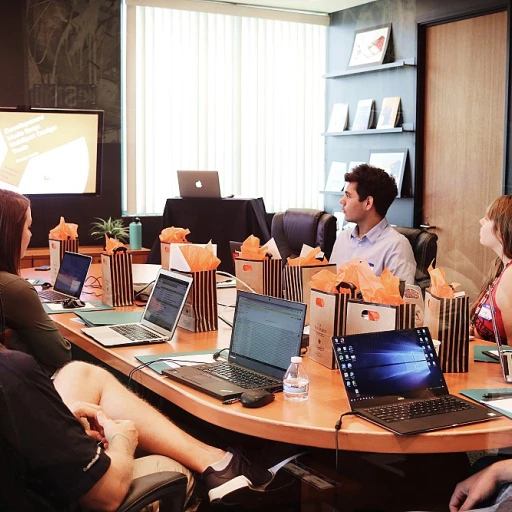Understanding the Need for Standardization
The Rationale for a Uniform Approach
In the competitive realm of recruitment, companies inevitably experience hurdles when it comes to selecting the best candidates for a job. One tangible solution is the implementation of a standardized interview process. This approach brings structure and order, ensuring that every applicant is assessed against the same criteria, thereby facilitating fairer hiring decisions.
Standardization is crucial to minimize unconscious bias, which often sneaks in during unstructured interviews. When interviewers have a set list of questions they're required to pose, they focus on job requirements and skills rather than personal biases. Consequently, candidates are evaluated on a level playing field. This controlled environment not only helps in filtering suitable candidates but also enhances overall candidate experience.
Uniformity in the interview process acts as a beacon for both hiring teams and candidates. For hiring managers, structured interviews provide clear guidelines on how to gauge applicant suitability for the role. Simultaneously, job seekers appreciate the impartiality and consistency of standardized interview formats, which provide them with an equal opportunity to demonstrate their strengths.
Moreover, a standardized approach allows teams to streamline their recruitment process by saving valuable time. Through structured interviews, recruitment teams can focus on refining their techniques, improving candidate interactions, and optimizing their processes. This essence of efficiency is not only favorable in the current economy but imperative for maintaining a competitive edge.
For organizations seeking to align with best practices in recruitment, diving into standardization is not just a tactical decision—it's a strategic necessity. The proven benefits span far and wide, improving the quality of hiring outcomes significantly. To explore more on how standardized processes can reduce hiring discrepancies, you might find this article insightful.
Key Elements of a Standardized Interview Process
Building Blocks for Consistent Interviewing
Creating a standardized interview process is essential for improving the assessment of candidates during the hiring phase. Consistency is key, and structured interviews help ensure that every applicant is assessed fairly and thoroughly.- Structured Interview Format: A structured interview format sets the foundation for uniformity. This involves arranging interviews in a way that each candidate is asked the same set questions, ensuring that the evaluation is consistent across all potential hires. Interviewers will benefit from having a clear guide to follow, minimizing unconscious bias that can creep into more unstructured interviews.
- Interview Questions: Having a predefined pool of standardized questions is crucial. These questions should be directly related to the job requirements and tailored to measure relevant skills and experiences. Best practices suggest combining both behavioral and situational questions to gain a comprehensive view of the candidate's capabilities.
- Role-Specific Criteria: Clearly defining the skills and competencies required for the role allows hiring teams to create targeted interview questions. This tight alignment between job demands and the interview questions improves accuracy in candidate assessments, leading to better hiring decisions.
- Training Interviewers: It is essential to provide training for hiring managers and interviewers to ensure they understand the importance of the standardized process. Awareness and understanding of structured interviews and standardization principles can greatly enhance the recruitment process.
- Maintaining Applicant Experience: Even in a standardized setting, it’s important to personalize interactions as much as possible to improve candidate experience. Clear communication and feedback can make the structured interview process feel more engaging for job seekers.
Benefits of Standardizing Interviews
The Perks of a Uniform Interview
Standardizing interviews offers a plethora of benefits for companies and hiring teams looking to optimize their recruitment process. Here are some key advantages:- Reduction in Bias: By using structured interviews with set questions, hiring managers can significantly reduce the impact of unconscious bias. This ensures a fair evaluation of all candidates, focusing on their skills and fit for the role rather than subjective impressions.
- Improved Consistency: When every candidate is asked the same standardized questions, companies can ensure consistency in the interview process. This not only enhances the accuracy of the hiring decisions but also assures candidates that the process is transparent and equitable.
- Enhanced Candidate Experience: A well-structured interview process can greatly improve candidate experience. Applicants appreciate clarity and predictability, and a standardized interview format helps in providing this. Moreover, candidates can better prepare for the interview, resulting in more meaningful responses that accurately reflect their qualifications for the job.
- Efficient Use of Time: By employing structured interviews, companies can streamline the hiring process. Efficiency is achieved as interviewers can focus directly on the job requirements and key skills needed, without dwelling on irrelevant topics. This leads to a more productive allocation of time for both interviewers and candidates.
- Better Hiring Outcomes: Companies that incorporate structured interviews often report higher satisfaction with their hiring outcomes. This process enables recruitment teams to make more informed decisions by comparing candidates on a level playing field, resulting in the selection of the best-fit candidate for the job.
Challenges in Implementing Standardized Interviews
Overcoming the Hurdles to Implementing Standardized Interviews
Implementing standardized interviews in the hiring process is not without its challenges. While the benefits are clear – reducing bias, ensuring fairness, and improving candidate experience – the path to achieving a structured interview system can be fraught with difficulties. Here, we delve into some common challenges faced by hiring managers and recruitment teams in this endeavor.- Resistance to Change: One of the principal barriers is resistance from hiring managers and interviewers who are accustomed to unstructured interviews. Convincing an established team to adopt a new system requires demonstrating the tangible benefits of structured interviews, such as improved hiring decisions and a more efficient recruitment process.
- Time Investment: Developing a set of standardized questions tailored to specific job requirements involves a significant upfront investment of time. Additionally, training interviewers to adhere to the new interview format and best practices can be resource-intensive. However, this initial effort can be viewed as an investment in the long-term effectiveness of the hiring process.
- Ensuring Consistency: Maintaining a consistent interview process across all candidates is crucial for fairness and reducing unconscious bias. This requires rigorous adherence to structured interview formats and the continual monitoring and evaluation of the process to ensure compliance and effectiveness.
- Balancing Structure and Flexibility: While structured interviews aim to standardize the process, hiring teams must also be willing to adapt and update the interview questions and formats based on feedback and evolving job needs. Balancing standardization with the ability to tailor the process to different roles and skills is a key consideration.
- Technical Challenges: Integrating tools and technologies for interview standardization, while beneficial, can pose technical challenges. Companies may face issues such as compatibility with existing systems or insufficient customization options, which require strategic planning and possibly, additional investment.
Tools and Technologies for Interview Standardization
Leveraging Technology in Interview Standardization
Integrating tools and technologies into the interview process can significantly enhance the effectiveness of standardized interviews. By utilizing advanced solutions, hiring teams can ensure consistency and objectivity, minimizing bias and optimizing the overall candidate experience.
Here are some key technologies that can aid in the standardization of interviews:
- Applicant Tracking Systems (ATS):
- Interview Scheduling Tools:
- Video Interview Platforms:
- AI-Powered Interview Tools:
- Collaboration and Feedback Platforms:
These platforms streamline the recruitment process by allowing hiring managers and teams to effectively manage candidates. They help ensure all candidates go through a structured interview process, maintaining consistency across the board.
Automation of interview scheduling can save significant time and reduce scheduling errors. Tools that offer calendar integrations ensure smooth coordination between interviewers and applicants, improving the overall experience.
Structured interviews can be conducted virtually, allowing hiring teams to maintain a standardized format through predefined questions. Video platforms also facilitate recording for later review, aiding in structured decision-making.
These tools can assist in reducing unconscious bias by analyzing responses based solely on pre-set criteria. Additionally, AI can offer insights into the skills and suitability of candidates for specific roles.
After the interview process, having a centralized platform for interviewer feedback ensures a comprehensive review of each candidate. These collaborative spaces help in refining guidelines and best practices for future structured interviews.
Adopting the right tools not only aids in maintaining a structured interview process but also supports the overarching goal of making fair and informed hiring decisions. As companies continue to adopt these technologies, their ability to tailor and improve the recruitment process will significantly contribute to a positive candidate experience and better hiring outcomes.












